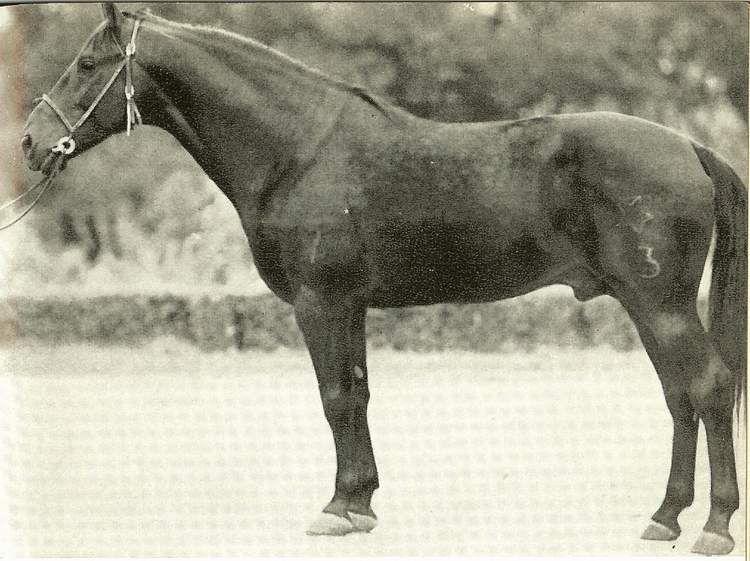

Kabarda


Introduction: It appears that there is (or at least, was) a Kabarda and an Anglo-Kabarda. One source says that the Kabarda is now crossed with the Thoroughbred so much that they simply call it the Anglo-Kabarda. My goal is to eventually have a page for every breed that has ever been, even if it is now extinct. Until I know for sure that the Kabarda indeed no longer exists as a breed, I will speak of it in the present tense. If you have any comments or suggestions, please click here. Also, the above left picture is obviously more recent and somewhat more attractive, but so dark as to make it difficult to see the conformation; for the latter purpose, you may admire the above right picture, of a stallion named Diktator.
Names: Kabarda, Kabardin. I am actually more familiar with the latter, but I will use both for now.
Origin: This
is a native North Caucasian breed found mainly in the Kabardino-Balkar
Autonomous Republic and in the foothills area of Stavropol territory. In the
process of its formation the Kabarda was influenced by many breeds--steppe
horses, the Karabakh
, the Persian and the Turkmenian (or Turkoman).
Trade between some Caucasians and Muslims
of the Near East, resulted in well-bred, eastern-type stallions arriving in some
Caucasus regions where they were mated with the local mares of Mongolian
stock. Kabarda horses are
kept in taboons and transferred to mountain pastures in summer and to the
foothills area in winter.
Breeding area and studs--USSR, both sides of the Caucasus,
along the Black Sea, Terek region. Foundation type of the Circassian
horse. Systematically improved since the Russian Revolution.
One of a number of medium-sized horse-breeds found in the
Caucasus mountain regions of the former U.S.S.R. Other Russian breeds of
the same size (60-64 inches), but varying in coloration, have similar and
sometimes confusing names: Karabair, Karabakh (or Karabagh), Kazakh, etc.
Altogether, Russia has today perhaps fifty breeds or types of horses.
Breeding: The
purebred population recorded in volumes I-III (1935-53) of the studbook was 446
stallions and 3,272 mares. The breed's breeding nucleus has dropped to 400-450
mares concentrated at Malokarachaevski and Malkinski studs and at the horse
breeding farms of the Karachaevo-Cherkess Autonomous Region. One source implies
that the sharp decline
of the pedigree nucleus stock can be explained by the insufficient speed of Kabarda
horses in hippodrome tests. This would explain the interest
in the newer Anglo-Kabarda
breed.
The main breeding centers for the Kabarda are
Malkinski stud in the Kabardino-Balkar Autonomous Republic, and Malokarachaevski
stud and the breeding farm of Krasny Partizan collective farm in Stavropol
territory. There are 4 blood lines in the breed. A new breed group has
been formed by crossing the Kabarda with the Thoroughbred, the blood of the
latter being from 5/8 to 3/4. The Anglo-Kabarda
was recognized as a breed group in 1966. The breeding farms of Kabardino-Balkar and Stavropol regions breed
both purebred Kabarda and Anglo-Kabarda
horses. The Kabarda needs protection.
Description: The Kabarda has a solid clean build.
Action: Excellent walk, very surefooted; exceptional galloping ability.
Body: Neck long to medium-long, straight, slender, and well-muscled; frequently ewe-necked. Back straight, solid, and rather short, as are quarters which are usually sloping. Chest deep and long-ribbed. Croup slightly sloping and heavily muscled. Loin well muscled; shoulders medium-long and correctly sloping. Withers medium-high and long.
Color: Predominantly cherry bay; often bay brown; black is rare. Another source said colour is usually grey.
Hair: Moderate hair coat. Mane and tail may be quite thick. May have feather. Heavily covered and beautifully set on tail.
Head: Clean, sometimes coarse, with ram profile, long ears, and usually a short poll. Often with slightly convex profile, light and clean.
Hooves: Exceptionally hard and tough, but with a disposition to contracted heels.
Legs: Hard, correctly set and with strong muscles. Hind legs often bowed. Joints well developed and clean.
Size: The measurements below are a little advanced for
me. In brief, it could be said that the Kabarda averages 14 to 15
hands. The measurements for the stallions below show that they averaged
just over 15 hands.
The bulk of the horses are not large. Their
average height ranges from 145 to 152 cm. However, the measurements (in
centimeters) of
stallions at studs were as follows: height at withers 155, oblique body length
153, chest girth 180, cannon bone girth 20.
Temperament:
Features: The
Kabarda horse is well fitted for mountain and stony terrain. It can show a fair speed and remarkable endurance.
The breed's speed record is 1 min 54 sec for 1600 m and 2 min 44.2 sec for 2400
m. The record for the 50 km long distance is 1 hour 41 min 25 sec. The
first record could translate to just under a mile in 1 minute and 54 seconds.
Similar to the Don
in type and calibre. Extremely
refined riding breed with exceptional keenness to gallop on. Great
stamina. Very surefooted in the mountains.
Uses: The Anglo-Kabarda horses participate at national and Olympic events and are used as saddle mounts on farms of the northern Caucasus. They make first-class mountain horses. The Kabarda is primarily a saddle horse.
Accomplishments:
Curiosities:
Profiles:
Conclusion: